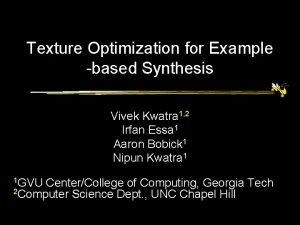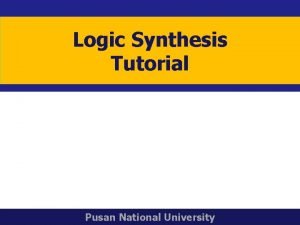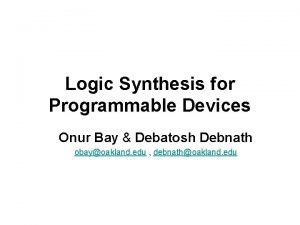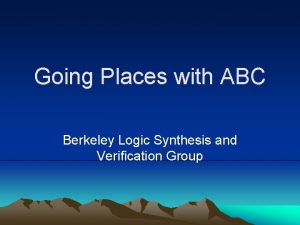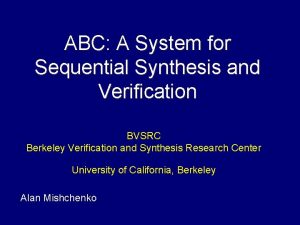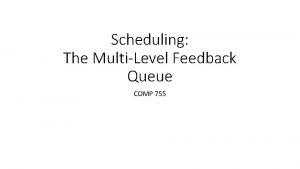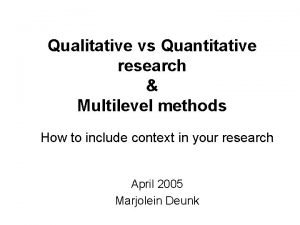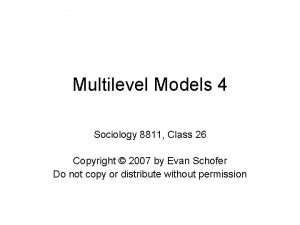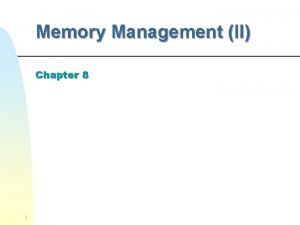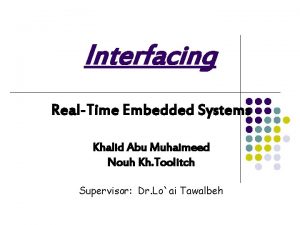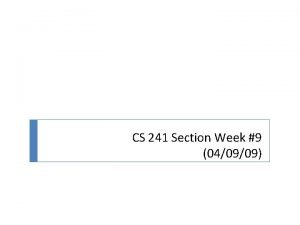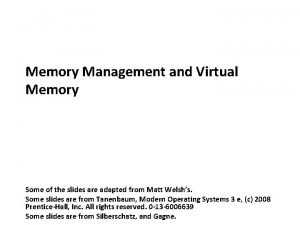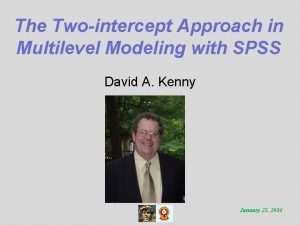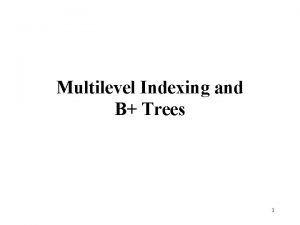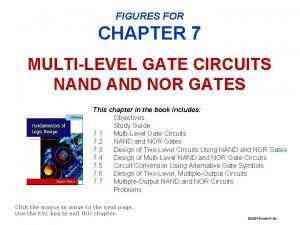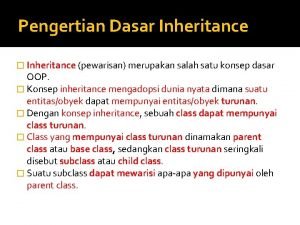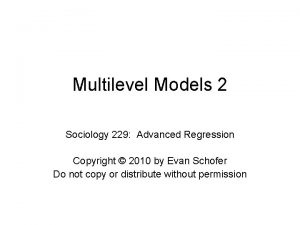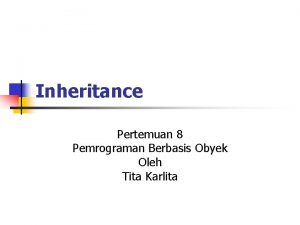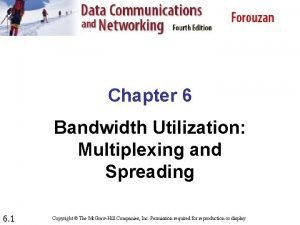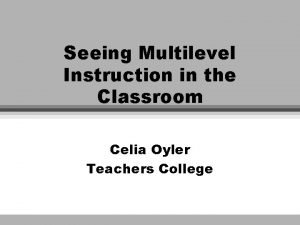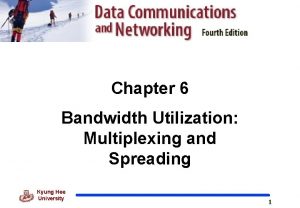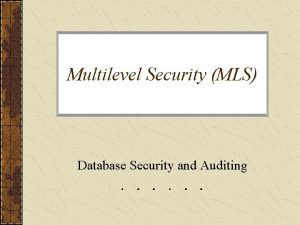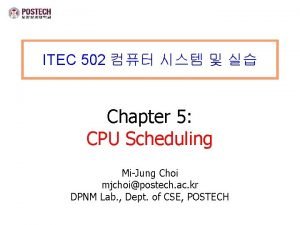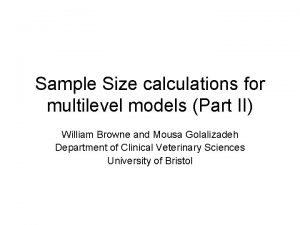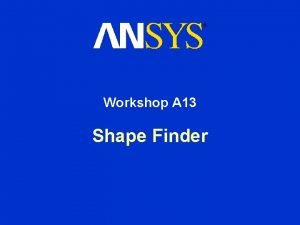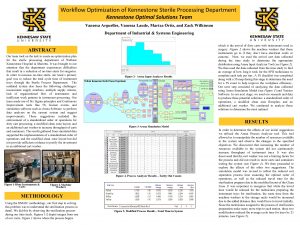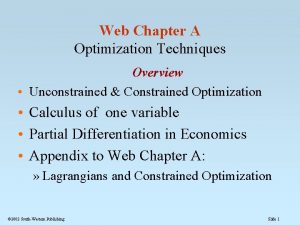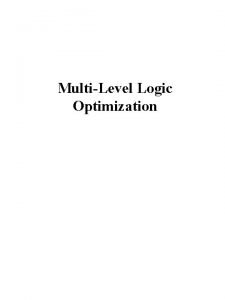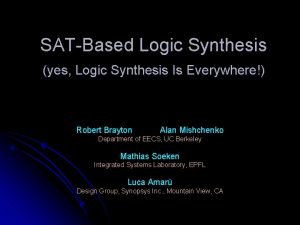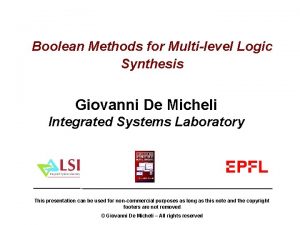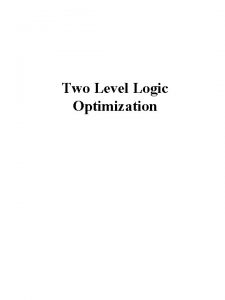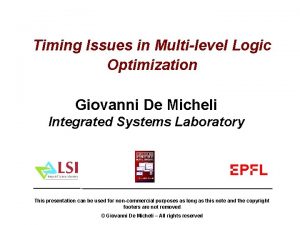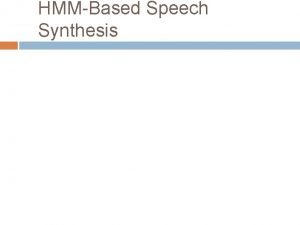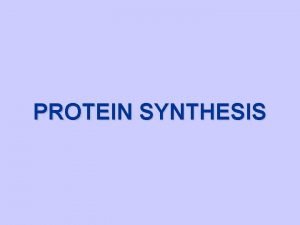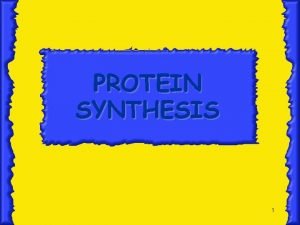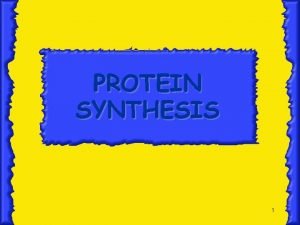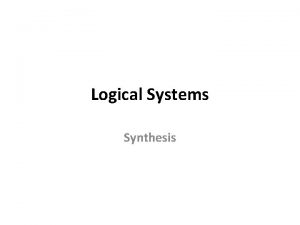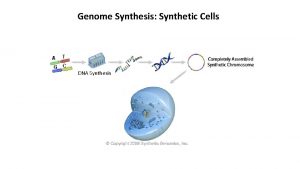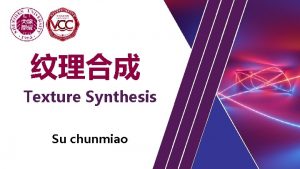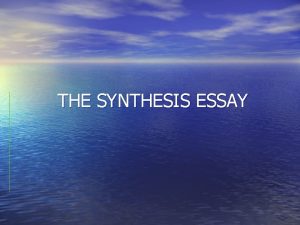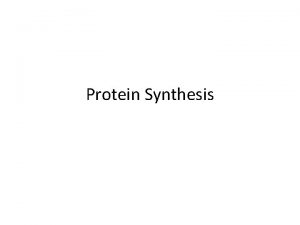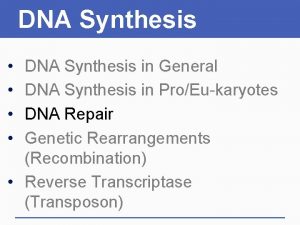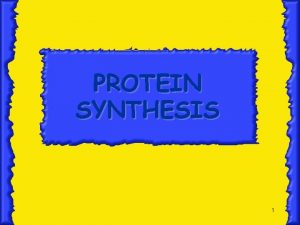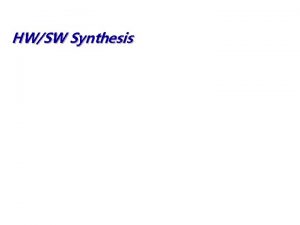MultiLevel Logic Optimization 1 MultiLevel Logic Synthesis Two











































- Slides: 43

Multi-Level Logic Optimization 1

Multi-Level Logic Synthesis • Two Level Logic : – Espresso – Programmable Logic Array (PLA) • Multilevel Logic : – Standard Cell – Gate Array 2

Multi-level logic • Standard cell implementation: o 1 i 1 inverter o 1 i 2 NAND i 1 i 2 i 3 AOI 21 Y AOI 21 (x) NAND (y) A NAND (z) B INV (w) C 3

Different Placement y z x w A B C Y y A B C z x w Y 4

Local Optimization 1 2 3 4 a b c d f l k 5

Circuit Restructuring a c b c a d f c b f a d 6

Representation Choices • How to represent the function? • How to represent the implementation? Two-level logic : two issues are merged Multi-level logic : . merged view (representation and implementation are one). separated view 7

Boolean Network x 1 x 2 x 3 x 4 x 5 x 6 y 1 y 2 y 4 y 3 y 5 z 1 z 2 • Directed Acyclic Graph (DAG) • Primary Input (PI) • Primary Output (PO) • Intermediate node : logic function fi, variable yi • Edge • Fan-in, transitive fan-in 8 • Fan-out, transitive fan-out

Node Representation (1) Sum-of-Product abc’+a’bd+b’d’+b’e’f adv : – easy to manipulate and minimize – many algorithms available disadv: – not representative of logic complexity f = ad+ae+bd+be+cd+ce f’ = a’b’c’+d’e’ – not easy to estimate if logic becoming simpler 9

Node Representation (2) factored form : Any depth of sum of product Ex: a a’ ab’c ab+c’d (a+b)(c+a’+de)+f 10

Node Representation a c d c b b a c d c A CMOS complex gate implementing f = ((a+bc)(c+d))’ 2 * literal count = transistors# adv: • natural multi-level representation • good estimate of the complexity of function • represent both the function and its complement disadv: • more difficult to manipulate than two-level form 11 • lack of the notion of optimality

Node Representation (3) NAND or NOR form a b c c d A Simple Gate Implementation of f = ((a+bc)(c+d))’ adv : • simple data structure storage -save fast simulation • efficient optimization strategies for rulebased logic optimization • complete with inverter count disadv: • The network is finely decomposed in a 12 particular way and this may obscure some natural structures.

Multi-level Logic Optimization Technology Independent • Decomposition/Restructuring Algebraic (Boolean) Functional • Node Optimization Technology Dependent • Technology mapping 13

Technology Independent Phase • Restructuring Basic Operations: 1. decomposition (single function) f = abc+abd+a’c’d’+b’c’d’ f = xy + x’y’ x = ab y = c+d 2. extraction (multiple funciton) f = (az+bz’)cd+e g = (az+bz’)e’ h = cde f = xy + e g = xe’ h = ye x = az+bz’ y = cd 14

Technology Independent Phase 3. factoring (series-parallel decomposition) f = ac+ad+bc+bd+e f = (a+b)(c+d)+e 4. substitution g = a+b f = a+bc f = g(a+c) 5. collapsing f = ga+g’b g = c+d boolean x + x’ = 1 x x’ = 0 (a+b)(a+c) =a+ac+ba+cb f = ac+ad+bc’d’ g=c+d “Division” plays a key role in all these operations. 15

Algebraic and Boolean Operations • Algebraic operations: – Algebra of expression involving real numbers – Those rules that are common to the algebra of real numbers and Boolean Algebra. • Boolean operations: – All laws of Boolean Algebra 16

Boolean Algebra • Rules hold for Boolean Algebra only – Idempotency a a = a 2 (real number) a a = a (Boolean Algebra) – Complementation No direct correspondence in real field – Distributivity of “+” over “ “ a + bc = (a+b)(a+c) in Boolean Algebra Not in real number – Absorption a + ab = a in Boolean Algebra Not in real number 17

Boolean Divide • Def 1: p is a Boolean divisor of f if q f and r exists such that f = pq + r (p is said to be a factor of f if r = f ) (1) q is called the quotient , f/p (2) r is called the remainder (3) q and r are not unique Let = (f, d, r) • Def 2 : g is a Boolean divisor of f if there exists h such that f gh + e f + d (d : don’t care) 18

Boolean Divide • Theorem 1: A logic function g is a Boolean factor of a logic function of f <=> f g g f • Theorem 2 If f g f , then g is a Boolean divisor of f. g f f = gq + r too many Divisor (factors)! 19

Algebraic Divide • Def 3: f is an algebraic expression if f is a set of cubes such that no one cube contains another. Ex: a + ab is not an algebraic expression because a contains ab. ab + bd is an algebraic expression • Def 4: f g is an algebraic product if f and g are algebraic expression and have disjoint support (no input variable in common). Otherwise, f g is a Boolean product. Ex: (a+b)(c+d) = ac+ad+bc+bd => Algebraic product (a+b)(a+c) = aa+ac+ba+ba => Boolean product 20

Weak Division Given f and p , return q and r such that pq is an algebraic product and f = pq + r 21

Algebraic Divide • Weak-Div (f, p) U = set {Uj} of cubes in f with literals not in p deleted V = set {Vj} of cubes in f with literals in P deleted i = {Vj V : U j = p i} i q= r = f - pq Ex: f = ac + ad + ae + bc +bd +be +a’b p=a+b U=a+a+a+b+b V = c + d + e + a’ a =c+d+e b = c + d + e + a’ b = c + d + e r = f - pq = a’b q= a 22

Boolean Division • Theorem f 1 = hx + e be a cover of an incompletely specified function (f, d, r). Suppose x’g +xg’ d where g is any function. Then, f 2 = hg + e is also a cover. • Algorithm 1. f = h g + e (where h = f/g) 2. use a new variable x to represent g, f=h x+e 3. form the don’t care set, xg’ + x’g 4. minimize f with the don’t care 5. quotient f/x (quotient = the terms of f with x) remainder = the terms of f without x) 23

Substitution • An existing node in a network may be a useful divisor in another node. fi fj 24

Algebraic Substitution • dividing the function fi at node i by fj or fj’ at node j pair-wise. • If fj is a divisor of fi fi = g y j + r no need to try all pairs ( Cases where fj is not an algebraic divisor of fi) 1. fj contains a literal not in fi 2. fj contains more terms than fi 3. for any literal, the count in fj exceed that in fi 4. fi is fj’s transitive fan-in ( cycle ) 25

Boolean Substitution • Ex: f = a + bc g=a+b substituting g into f (Let X = a + b) DC = X(a + b)’ + X’(a + b) minimize (a + bc) DC’ (force X to appear in f) => (a + bc)(X(a + b)’ + X’(a + b))’ using Don’t Care = X(a + b)’ + X’(a + b) • A minimum cover is a + bc. But it does not contain X or X’ • force X (or X’) to remain in f => f = a + Xc f = a + gc g=a+b 26

Division • • Substitution : knows divisor ? Yes Extraction : knows divisor ? No Factor : knows divisor ? No Decomposition : knows divisor ? No 27

Kernel • Kernel : for finding divisor (algebraic) – What is kernel? – Kernel algorithm – kernel intersection • Too many divisor, but much smaller number of kernel. 28

Kernel • Definition: An expression is cube-free if no cube divides the expressions evenly. Ex: a + bc is cube-free ab + ac is not cube-free abc is not cube-free • Definition: The kernel of an expression f are the set of expression (f) = { f/c | f/c is cube free and c is a cube} Ex: f = acb + acd + e a kernel f /a = cb + cd not a kernel f/ac = b + d a kernel 29

Kernel • Definition : A cube c used to obtain the kernel k=f/c is a co-kernel c(f) denotes the set of co-kernel. Ex: f = adf + aef + bdf + bef + cdf + cef + g = (a + b + c)(d + e)f + g kernel a+b+c d+e (a+b+c)(d+e)f+g co-kernel df, ef af, bf, cf f 1 30

Kernel • Theorem: f and g have a common multiple-cube divisor d <=> hf (f) hg (g) such that d = hf hg Ex: f 1 = ab (cl + f + g) + m f 2 = ai (cl + f + j) + k (f 1) = { cl + f + g } (f 2) = { cl + f + j } (f 1) (f 2) = cl + f common multiple cube divisor cl + f 31

Kernel • The level of a kernel A kernel is level-0 if it has no kernels except itself. A kernel is level-n if it has at least one level n-1 kernel but no kernel (except itself) of level n or higher. Ex: f = (a+b+c)(d+e)f + g kernel level a+b+c 0 d+e 0 (a+b+c)(d+e) 1 (a+b+c)(d+e)f + g 2 32

Kernel • Why need to define level of kernel? – sometimes it is nearly as effective to compute a certain subset of kernel – computation time and quality trade off 33

Kernel Algorithm literal index expression Kernel( j , g) R= for (i=j ; i n ; i++){ if (li appears in more than one cube) c = largest cube dividing g/{li} evenly if (lk c for all k < i) R = R Kernel (i+1, g/({li} c)) } R = R {g} Return R • The literals in the support of f are numbered from 1 to n. 34

Kernel Algorithm f = abcd+abce+adfg+aefg+abde+acdef+beg a b c e f c d e (a) b c d e c (a)(a) ac+ad+g d ed f b+cf ce+g g d+e c+d cd+g d+e c+e b+ef b+df co-kernel 1 a ab abc abd abe ac acd kernel a((bc+fg)(d+e)+de(b+cf)))+beg (bc+fg)(d+e)+de(b+cf) c(d+e)+de d+e c+d b(d+e)+def b+ef Note : f/bc = ad+ae = a(d+e). 35

Kernel Intersection • Kernel Intersection K = { 1, 2, . . . n } • Form a new expression IF(k) which corresponds to the set K of kernel – associate each distinct cube with a new literal – each kernel corresponds to a cube of the new function – Then, every element in the set of co-kernel of IF(K) corresponds to a unique kernel intersection. 36

Example Ex: K 1 = abc + de + fg = t 1 t 2 t 3 K 2 = abc + de + fh = t 1 t 2 t 4 K 3 = abc + fh + gh = t 1 t 4 t 5 IF(K) = t 1 t 2 t 3 + t 1 t 2 t 4 + t 1 t 4 t 5 Co-kernel of (IF(k)) = {t 1, t 1 t 2, t 1 t 4} 37

Kernel Extraction • Kernel extraction (k, n) 1. Find all kernels of all functions and generate all kernel intersections. 2. Choose one with best “value”. 3. Create a new node with this as function. 4. Algebraically substitute new node everywhere. 5. Repeat 1, 2, 3, 4 until value threshold. • Step 1: Selection of level of kernel determines speed and quality trade off. • Step 2: y(new node) area-value(y) = freq(y) * literal(y) - freq(y) 38

Factor • Factor(F) 1. If F = 1 return False 2. D = Choose_Divisor(F) 3. (Q, R) = Divide(F, D) 4. Return. Factor(Q)*Factor(D) + Factor(R) • Efficiency and quality Step 2 : Divisor : 1. choose literal factor 2. choose one level-0 kernel 3. choose the best kernel Step 3 : Algebraic divide Boolean divide 39

Decomposition • Decomposition – similar to factoring, except that each divisor is formed as a new node – For each method of factoring, we have the associated method for decomposition. 40

Example Ex: f 1 = ab(c(d+e)+f+g)+h f 2 = ai(c(d+e)+f+j)+k – extraction(level-0 kernel) 0(f ) = {d+e} 1 0(f ) = {d+e} 2 0(f ) = {d+e} 1 2 l=d+e f 1 = ab(cl+f+g)+h f 2 = ai(cl+f+j)+k – extraction (level-0 kernel) 0(f 1) = {cl+f+g} 0(f ) = {cl+f+j} 2 0(f 1) 0(f 2) = {cl+f} m = cl+f l = d+e f 1 = ab(m+g)+h f 2 = ai(m+j)+k No kernel intersection at 41 this point

Example (cont. ) – cube extraction n = am m = cl+f l = d+e f 1 = b(n+ag)+h f 2 = i(n+aj)+k l = d+e 2*1 -2 -1 = -1 m = cl+f 3*1 -3 -1 = -1 n = am 2*2 -2 -2 = 0 f 1 = b(n+ah)+h f 2 = i(n+aj)+k 42

Example (cont. ) – eliminate -1 (collapsing) n = a(c(d+e)+f) f 1 = b(n+ah)+h f 2 = i(n+aj)+k 43
 Vivek kwatra
Vivek kwatra Logic synthesis
Logic synthesis Logic synthesis
Logic synthesis Abc berkeley
Abc berkeley Abc logic synthesis
Abc logic synthesis Multi level page table
Multi level page table Teaching multilevel esl classes
Teaching multilevel esl classes What is multilevel feedback queue scheduling
What is multilevel feedback queue scheduling Multilevel model equation example
Multilevel model equation example Multilevel model equation example
Multilevel model equation example Multilevel paging in os
Multilevel paging in os Interfacing in embedded systems
Interfacing in embedded systems Multilevel page tables
Multilevel page tables Virtual memory linux
Virtual memory linux Multilevel modeling spss
Multilevel modeling spss Mfq scheduling
Mfq scheduling Multilevel indexing
Multilevel indexing What is an indices
What is an indices Multilevel nand circuits
Multilevel nand circuits Inheritance adalah
Inheritance adalah Advanced regression and multilevel models
Advanced regression and multilevel models Multi level instruction
Multi level instruction Contoh multilevel inheritance
Contoh multilevel inheritance Multiplexing and spreading
Multiplexing and spreading Multi level security example
Multi level security example Celia oyler
Celia oyler Multilevel scheme in data communication
Multilevel scheme in data communication Bandwidth utilization multiplexing and spreading
Bandwidth utilization multiplexing and spreading Multilevel security in database
Multilevel security in database Cpu scheduling gantt chart
Cpu scheduling gantt chart Sample size calculations in multilevel modelling
Sample size calculations in multilevel modelling First order logic vs propositional logic
First order logic vs propositional logic First order logic vs propositional logic
First order logic vs propositional logic First order logic vs propositional logic
First order logic vs propositional logic Combinational logic circuit vs sequential
Combinational logic circuit vs sequential Cryptarithmetic problem logic+logic=prolog
Cryptarithmetic problem logic+logic=prolog 캠블리 단점
캠블리 단점 Is it x y or y x
Is it x y or y x Combinational logic sequential logic 차이
Combinational logic sequential logic 차이 Logic chapter 3
Logic chapter 3 Font finder
Font finder Optimize sterile supply workflow
Optimize sterile supply workflow Constrained and unconstrained optimization in economics
Constrained and unconstrained optimization in economics Amager resource center
Amager resource center
